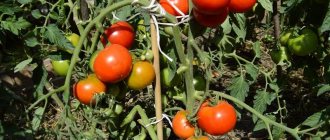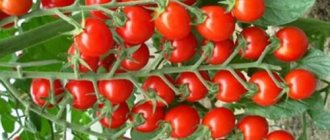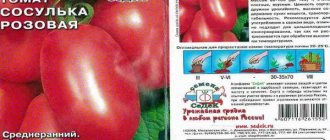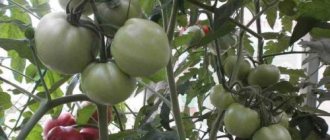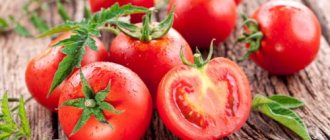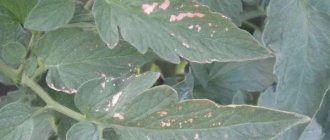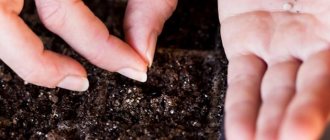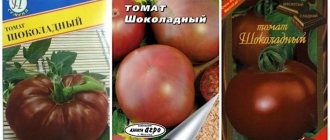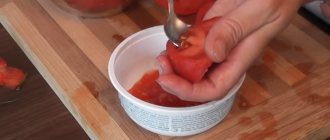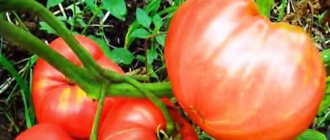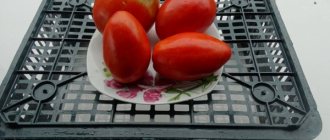Every farmer invariably has his favorite tomato varieties. The favorite of many has become the Dacha Favorite - a highly productive and amazingly tasty tomato.
| Height | Landing location | Ripening time | Fruit color | Fruit size | Origin | Fruit shape |
| short | Greenhouse, Open ground | Early ripening | Reds | Average | Variety | Round |
Planting and care
Tomatoes of the Dachnik variety can be grown in two ways: by pre-planting seedlings or by sowing directly into open ground with the onset of warm weather. Under shelter, tomatoes will sprout well and after 3.5 months the first harvest can be harvested. However, in cold regions, with this approach, the harvest will appear only in August. In this regard, in most cases, Summer Residents are grown by seedlings. Further care includes basic agrotechnical measures. Moderately heavy fertile soil is suitable for tomatoes.
Terms and rules for sowing seeds
You should not plant seeds for seedlings too early, since the Dachnik variety is prone to a rapid transition to the flowering phase. Therefore, seeds should be sown at the end of March, since by two months the bushes already begin to flower. Provided there is shelter, seedlings can be planted in the middle zone in early May, so seeds are sown in mid-March or early April. To grow seedlings you will not need special pots: it will be enough to grow the seeds in a common box.
Seed material must be prepared in advance: the seeds are soaked in a weak solution of potassium permanganate and left for 20 minutes. The exception is agro seeds - such planting material is initially treated with special compounds. The seeds are planted in a container with loose soil to a depth of 1 cm. Next, the containers are covered with film, and the room temperature should be up to 25 degrees. From time to time, seedlings should be hardened off and taken outside. A week before planting, the pots are placed on the windowsill so that they get used to the sun's rays.
Picking seedlings and transplanting into open ground
Planting in open ground is carried out in May. When two true leaves appear, a pick is made, leaving the main root unpinned. You can plant seedlings in open ground or a greenhouse only on the 50th day of their growth. As a rule, it does not stretch out and easily tolerates picking. On one square m it is recommended to place up to eight tomato bushes. For planting, holes are made up to 3 cm deep, and the distance between the bushes is 20 cm. After careful digging, compost and humus are added to the soil. After planting is completed, the seedlings are watered generously and mulched with sawdust or hay.
Irrigation and fertilization of bushes
Tomatoes are watered generously once a week. During the fruiting period, you should not greatly reduce the frequency of watering, since Dachnik tomatoes are not susceptible to cracking from excess moisture. It is advisable to introduce fertilizer mixtures, however, it is not necessary if the bed is initially rich in nutrients. Fertilizing with mineral fertilizers is carried out up to three times per season:
- The first time fertilizer is applied after planting the seedlings. It is recommended to use mullein infusion with the addition of 3 g of boric acid.
- Then the fertilizer mixture is applied three weeks later. At this stage, you will need a composition of mullein and potassium sulfate.
- Then, every three weeks, rotted manure is applied directly under the bush.
- As a preventative measure, spraying inflorescences and fruits with boric acid is used.
As fertilizers, it is allowed to use organic matter (diluted), iodine, yeast, boric acid, hydrogen peroxide and ammonia. Ash, which is added during the main watering or sprinkled on the soil around the bush, gives a positive result for the growth of tomatoes. All treatments are stopped 3-4 weeks before fruiting.
Shaping and garter
The Summer Resident tomato variety does not need a garter, since its stem is powerful enough to support the weight of the fruit. In some cases, the fruits ripen well on straw, which is used to mulch the bush. In this regard, garter stakes are installed at will. It is recommended to form the Summer Resident tomato bush into three or four stems. It is also recommended to remove the lower leaves for better ventilation. In addition, you should periodically loosen the soil and remove weeds that attract pests.
Diseases and pests: treatment and prevention
Dachnik tomatoes are resistant to fusarium and blossom end rot. But, unfortunately, this variety is not able to resist late blight. To prevent the development of fungus after planting, the beds are treated with Bordeaux mixture or copper sulfate. Another effective preventive measure is treating the bushes with kefir, wood ash or potassium permanganate with garlic. Often, the drug “Ordan” is used to combat this disease. The greatest danger to bushes are the following insects: slugs, mole crickets, ticks and Colorado potato beetles. Insecticides are used to eliminate them. Prevention of pests is by planting plants with repellent aromas (garlic, onion, wormwood).
Tomato Summer resident variety description
The Summer Resident tomato is not young: it was registered in the State Register of the Russian Federation in 1999. The variety was obtained by specialists from the All-Russian Research Institute of Vegetable Growing; the originator was, among other things, the seed industry. At that time, there was no such wave of new varieties and hybrids, and each new product could be tracked by amateur gardeners.
The summer resident turned out to be a lifesaver for many enthusiasts, although it is officially approved for cultivation only in the North Caucasus region, of course, in open ground. Yes, it is not profitable to plant this tomato in a greenhouse: its bush is not tall, and a lot of free space will be wasted. But in those regions where tomatoes can grow without greenhouses, gardeners began to plant this variety with pleasure.
A brief description of the tomato variety Dachnik according to the State Register
The Dachnik variety is a representative of determinate tomatoes; its bushes rarely exceed the half-meter mark in height and practically do not require the formation or even tying of shoots. The bush is semi-spreading in shape, branching and foliage are at an average level. Leaves are of normal size and color. 4–5 fruits are formed in the cluster.
The summer resident’s bushes are small, but covered with fruits
In terms of ripening time, the variety is classified as an early ripening variety; the first fruits ripen approximately 100 days after germination. In the south, it is sometimes even considered ultra-early, although now there are many varieties that ripen a week or two earlier than Dachnik. The first wave of the harvest, lasting one and a half to two weeks, is the main one, then fruiting continues little by little until frost.
The fruits are medium-sized, round or flat-round in shape, scarlet or red in color, containing at least four seed nests. The weight is in the range of 50–100 g: tomatoes cannot be called leveled. The taste of fresh fruits is characterized as good, with a pronounced “tomato” aroma. The skin is thin, the pulp is medium dense. The main purpose is salad, but the size of the fruit allows them to be preserved as a whole.
Since at the time of its appearance the variety was recommended for commercial production, that is, for large agricultural enterprises, its tests were carried out not in small gardens, but in field conditions, where it showed good yield. In official documents it is given in terms of per hectare.
On average, the variety produces from 250 to 350 c/ha, which is at the level of standard commercial varieties. In the open ground, summer residents, with not very careful care, can harvest up to 4 kg of tomatoes per square meter. The possibility of industrial cultivation is based, among other things, on the good transportability of the crop. Fresh tomatoes can be stored for up to three weeks.
The variety is highly resistant to diseases, including fusarium and blossom end rot. Despite its regionalization in the south, it has good cold resistance. Since the bushes of this tomato are quite compact and stocky, it is often planted indoors, as well as on the balcony.
The Summer Resident tomato can be grown without preparing seedlings, especially in the recommended North Caucasus region. Seeds sown directly into the garden bed with the onset of warm weather or under temporary shelter will sprout perfectly, and after the required 3.5 months it will be possible to harvest ripe tomatoes. But in regions that are not the warmest, this approach will allow you to harvest only in August, when you no longer really want tomatoes that don’t have the most exquisite taste. Therefore, in most areas, Dacha is grown through the seedling stage.
Seedlings of this tomato are easy to obtain; you should not sow the seeds too early. After all, seedlings can be planted in a garden bed only at the onset of summer, but for a summer resident they are ready for planting already at the age of one and a half months. By two months the bushes are already beginning to bloom. But the small growth of tomatoes makes it easier to install temporary shelters, which is often used to obtain an earlier harvest. Under this condition, in the middle zone, planting seedlings is possible as early as May 10–15, which means that seeds can be sown in boxes in mid-March.
No pots are required to grow Summer Resident seedlings: stocky plants grow well in a common box
The fruits of the Summer Resident tomato mostly have time to ripen on the bushes; there is no need to pick them unripe: this is done only in the fall, before frost, but by then only a few specimens remain in the beds.
Tomato Summer resident is a variety for busy gardeners. It does not require special care and reliably produces early harvests of quite good tomatoes.
When growing garden crops, many summer residents dream of varieties that could be planted in the beds and forget about caring for them. Some will say that such cultivated plants do not exist. But this is only because not all vegetable growers have heard about the Dachnik tomato variety.
The Dachnik tomato variety is not distinguished by its high yield, unusual size or coloring of fruits, and farmers who grow tomatoes on an industrial scale are unlikely to be interested in it. But for vegetable growers who grow vegetables in their small garden, the Dacha tomato will truly be a godsend - the productivity of this variety is average, but stable in all weather conditions, and even a person who has never grown vegetable crops before can grow Dacha tomatoes in their garden.
Tomatoes of the Dachnik variety belong to the determinate type, so their bushes are compact and low (the central shoot reaches 70-75 cm in height), they do not take up much space in the beds, but at the same time they are highly productive.
It is not necessary to tie up the Summer Resident tomato bushes, but it should be taken into account that the shoots may fall to the ground or even break under the weight of ripening fruits.
But at the same time, the Dacha tomato bushes are very powerful and stocky, despite their compactness, and the same can be said about the seedlings of this variety.
Important! Due to the compactness and small height of this tomato, the small size of ripe tomatoes and unpretentiousness to growing conditions, many vegetable growers grow the Dachnik variety on a glassed-in balcony or even a windowsill. At the same time, the yield of these tomatoes does not differ much from that of tomatoes grown in open ground.
The Summer Resident tomato was created specifically for growing in open ground beds and is adapted for normal fruiting even in adverse weather conditions.
The shoots of this variety are medium leafy and dark green in color. The foliage is less than medium in size, typically tomato-like, narrow, and deep emerald in color.
The inflorescences are formed in the internodes, they are racemose, the flowers are small, yellow. Each inflorescence produces up to 10 ovaries.
The Summer Resident tomato is distinguished by its early fruit ripening period - from the germination of seed material to the harvesting of the first tomatoes, it takes 3 months or more. Therefore, many vegetable growers classify the Dachnik variety even as an ultra-early tomato variety.
Ripe fruits of this variety are flat-round and have no ribbing. During the ripening process, the color of the thin, dense skin is soft-salad; as the tomatoes ripen, they become bright scarlet. The tomato pulp is juicy, the number of seed chambers is 4-6 pieces.
Tomatoes are small in size, the weight of one is 75-85 g, the taste of the Dachnik tomato is pleasant, with a characteristic sourness and a typical tomato aroma. The amount of dry matter in ripe fruits is at least 5.5%, sugars - up to 3.2%, vitamin C in 100 g of pulp - at least 17 mg.
Thanks to their dense skin, the fruits are not prone to cracking, tolerate transportation well over any distance, and can also be stored for quite a long time.
The harvested crop has a universal purpose - tomatoes are used fresh, added to salads and snacks, and canned. Ripe tomatoes do not crack during heat treatment, which is a valuable quality when pickling them.
The fruiting of the variety is extended over time, which is convenient for those vegetable growers who do not come to the plot every day; as a result, they harvest from the Dachnik tomato beds in small batches.
Summer resident tomato bushes are resistant to low temperatures - they do not stop growing and bearing fruit in such conditions, which is their undeniable advantage.
In early tomato varieties, the yield is most often not significant. But the Dacha tomato is a pleasant exception - with good care, each compact bush can harvest 3-4 kg of ripe produce. And when growing the variety on an industrial scale, up to 340-350 centners of ripe early tomatoes can be collected from one hectare. Moreover, fruits with good presentation make up from 70 to 100% of the harvest.
In most regions, this variety is grown in seedlings. It should be taken into account that seedlings grown at home should be planted in a permanent place 50 days after emergence. From this time the date of planting the Dacha tomato seeds for seedlings is counted. It is not recommended to plant overgrown seedlings in open ground - they will suffer for a long time and, as a result, will begin to bear fruit much later than we would like.
Therefore, seeds of the Dachnik tomato variety should not be planted before the last days of March. At the stage of 2-3 true leaves, seedlings should be picked, planted in separate containers. A couple of weeks before transplanting the Summer Resident tomatoes into open ground, grown and strengthened tomato seedlings should be hardened off.
Important! Tomato plants are transplanted into open ground when the soil warms up to 11-13 degrees Celsius.
| Variety name | Summer resident |
| general description | An early-ripening, determinate variety of tomatoes for growing in greenhouses, greenhouses and open ground |
| Originator | Russia |
| Ripening period | 96-105 days |
| Form | Flat-round with slightly pronounced ribbing near the stalk |
| Color | Red |
| Average weight of tomatoes | 55-110 grams |
| Application | Recommended for consumption fresh, in the form of purees, salads, juice, has proven to work well in canning |
| Productivity of the variety | 3.8-4.2 kilograms per bush |
| Features of cultivation | Standard agricultural technology |
| Disease resistance | resistant to blossom end rot and fusarium |
Tomato Heart Kiss: characteristics and description of the variety, yield with photos
All about the variety
The description of the Sweet Kiss variety is written on the seed package. Ripens approximately three months after sowing the seeds. Refers to small tomatoes. Adapts perfectly to any weather changes and tolerates cold weather well.
The fruits are round in shape. There are always a lot of them on a branch. The color is red. The skin is dense, smooth, shiny. These tomatoes are recognized as one of the sweetest varieties in the world. The taste and aroma are unique, rich tomato. They contain a large amount of sugar. Small cherry tomatoes are ideal for salads and slices. And when marinated, they turn out simply incomparable.
If someone wants to plant these crops in their garden, then they need to know how to grow them correctly and what conditions to create for the growth of this variety.
How to grow
Tomatoes are planted in a greenhouse or open soil with sprouted seedlings. These varieties of tomatoes are grown in seedlings. They grow best in greenhouses, where all special conditions are created for them. They love good soil, only then they produce a wonderful harvest.
At the beginning of spring, you already need to sow the seeds in special containers. Before sowing, they are treated with a fungal solution. Then cover with film. Seeds germinate well at a temperature of 22 degrees. When the first leaves appear, the film is removed and the shoots are planted separately in cups.
This picking is necessary so that they grow and eat better. During growth, plants need to be provided with sufficient light and water. Don't forget to feed with fertilizers. Then the bushes will begin to gain strength and get stronger day by day.
As soon as good spring weather sets in outside, the seedlings must be taken out onto the balcony for ventilation and hardening.
Sweet varieties always love fertile good soil. It is thanks to her that such a rich taste is obtained. It is prepared in advance: sand, peat, organic and mineral fertilizers, and humus are placed there. Before planting, it is necessary to water well and loosen.
They plant Kiss tomato bushes, measuring the distance so that it is convenient to approach them and for feeding them.
You need to tie up the seedlings right away, as they stretch high and quickly. They are usually knitted with ropes. The yield of the variety largely depends on care.
Tomatoes 'Bull's heart red' and 'Bull's heart orange'
This is one of my favorite varieties. In the summer I use it in a salad with plums, garlic, basil and olive oil, after removing the skin.
The small heart-shaped fruits of this hybrid are very popular with children.
Quality care
The characteristics of a tomato can tell you how to care for it, what conditions to create in order to ensure high-quality growth and abundant fruiting. Caring for small cherry tomatoes is not much different from caring for large varieties, but there are some nuances that must be observed.
- Tall bushes of this variety need staking, otherwise they will fall to the ground under the weight of vegetables.
- Tomatoes need to be provided with high-quality watering, but most importantly, do not overdo it.
- Loosening the soil, hilling, mulching.
- Water with warm water, preferably from a barrel. Water tomatoes into the ground at the root.
- Soak tomato seeds in manganese before planting.
- Spray tomatoes against diseases.
- Do not let the soil turn to stone, loosen it, hill it, mulch it.
- Remove weeds that interfere with the supply of vitamins and nutrition to crops.
- Several times during the summer you need to feed vegetables with mineral and organic fertilizers. Moreover, nitrogen fertilizers can be fed to tomatoes before the ovary forms.
- Spraying with special solutions against insects and diseases.
- Sometimes open the windows and doors of the greenhouse where the tomatoes grow for ventilation.
- If you plant it in open ground, you should always cover it with a film to protect it from dew and cold at night.
Which is better: determinant or indeterminate?
In order to understand which tomato is best, you need to know the meaning of these words:
- Determinate is a stem with limited growth, it grows to a certain height and the last point of growth ends in the ovary. Such bushes are usually planted in open areas where there is nowhere to tie the bushes.
- Indeterminate is a stem with unlimited growth; in this case, side shoots are not formed, and branches with tomatoes appear instead of leaves. The characteristic is this: if the growth of this stem is not stopped, it will bear fruit until frost. Typically, such tomatoes are grown in greenhouses; these varieties are the most popular in industry.
- There is another low-growing species - standard, it does not require gartering, pinching or pruning of leaves. It grows in both open and closed areas. But due to the small growth, the yield is low.
See also
Description of the tomato variety My Family, growing characteristics and yieldRead
Fruit characteristics
Tomatoes of this variety have the following characteristics:
- The fruits are round and smooth.
- The color of ripe tomatoes is bright red.
- The skin is thin but dense.
- The pulp is juicy pink-red.
- There are 4 or more seed chambers inside.
- The taste and aroma are characteristic of tomatoes, but with a slight sourness.
- Tomatoes contain about 5.6% dry matter.
- The fruits of the Summer Resident are small. In the open air, the average weight of one tomato is 55-95 g, and in a greenhouse it can reach up to 105-110 g.
- Sugar content is 3.3% of the total weight of the fruit. 100 g of tomatoes contain 17 mg of ascorbic acid.
- Tomatoes of the Dachnik variety are stored for a long time.
- When transported over long distances, they retain their integrity.
- The yield of marketable tomatoes from the total number of tomatoes is 75-100%.
- Harvesting takes place until the end of autumn. The fruits are collected in small batches as they ripen.
Tomato Favorite of the Moscow Region - description and characteristics of the variety
Features and characteristics of the variety
In agricultural breeders, they were lucky enough to develop a small-sized tomato variety for growing outdoors. Some plant crops under small film tunnels and temporary shelters.
Distinctive features of the Favorite of the Moscow Region:
- The plant does not need first-class conditions to grow well.
- It takes about 3 months to get the fruit, which is a short period of time for tomatoes to ripen.
- The bushes are the same size, rather compact (about 30 cm).
- On one hand with 8 fruits.
- The leaves have a faint green tint and are small in size.
- The bush does not grow green mass.
- Due to the small size of the plant, the bushes do not need to be tied up.
The main positive feature is unpretentiousness. The culture is capable of providing summer residents with good fruits both in hot and cold weather. Due to the fact that the fruits ripen early, the plant is not susceptible to late blight.
The culture has excellent performance. It is rare to get sick with TMV. Most gardeners have repeatedly noted that pest control needs to be carried out in a timely manner. A cone out of the blue or a whitefly can harm the plant. At night, the plant may suffer damage from slugs.
Harvest
For good germination of the variety, what can you do with excellent lighting. In its absence, there will be no ovaries and the saltyk of tomatoes will not be sweet, but sour. Usually the weather in the Moscow region is incredibly changeable.
The first tomatoes have a very unusual bitterness. The berries of the nightshade plant have a lot of sugar.
How to plant seedlings
The hybrid Nasha Masha is grown in seedlings, which allows young bushes to form a powerful root system and speed up harvesting. Seeds are planted 60–65 days before the intended planting in the ground.
Average sowing time:
- for the southern regions of Russia - the end of February - the first half of March;
- for the central ones - the second half of March;
- for the northern ones - early April.
Seed preparation
The seed material is pre-soaked in a growth stimulant so that the seedlings appear quickly and the germination percentage is high. Use “Zircon”, “Epin-Extra”, “Ecogel”, following the instructions on the package.
The manufacturer processes the hybrid seeds himself, but for additional disinfection, the seed is kept in a solution of potassium permanganate (30 minutes), then dried in the sun.
Soil and container
For sowing you will need:
- shallow plastic containers or boxes (7–10 cm) with drainage holes in the bottom;
- transparent film or glass according to the size of the containers;
- soil disinfected with potassium permanganate or high temperature.
For seedlings, purchase a universal soil mixture or prepare the substrate yourself from peat, river sand and turf soil in equal proportions.
Sowing
Sowing of tomatoes is carried out according to the following scheme:
- The container is filled with soil and lightly compacted.
- Make grooves 2 cm deep at a distance of 3-4 cm from each other.
- Seeds are placed one at a time at the bottom of the grooves, every 1-2 cm.
- Fill the grooves with soil and water with a small amount of water.
- Cover the container with film or glass that allows sunlight to pass through.
Seeds are germinated at a temperature of +25…+30 °C. The containers are placed near the battery or radiator while maintaining high humidity under the film and sealing the container tightly.
The first shoots appear 3–5 days after sowing. If the temperature is below +20 °C, the time period increases.
Seedling care
As soon as the first shoots appear, the film is removed and the container is placed in a well-lit place. For seedlings to be strong, the daylight hours should be 16 hours. Additionally, phytolamps are used.
In the early stages, water the seedlings carefully, at the root, using a pipette or syringe. The top layer of soil should remain moist. Only warm, settled water is suitable.
With the appearance of the first pair of true leaves, the seedlings are planted in separate containers, preferably directly into peat pots. This will allow you to avoid damaging the root system in the future when transplanting to a permanent location.
It is important to dive as early as possible, while the seedlings are taking root well.
Seedlings and their planting
Most summer residents living in the central part of the country prefer the seedling method of growing tomatoes. The method of collecting material does not matter at all. It can be either purchased in specialized stores or taken independently.
- In approximately 2-2.5 months, the correct soil for future seedlings is prepared, which must include peat, the necessary fertilizers with important microelements in its composition, and garden soil.
- A day before sowing, you need to get containers for planting seeds so that they are at a comfortable room temperature, soak the seeds in a solution of potassium permanganate or aloe juice, which must be washed under running water at a gentle temperature before planting.
- Planting is done in prepared soil, one seed per container, which is covered with soil no more than 1 cm, sprayed with warm water and covered with cling film to create a greenhouse effect.
- It is important to maintain the correct temperature in the containers - up to 24 degrees and water using a spray bottle. Before planting, it is necessary to fertilize the soil up to 3 times using biological fertilizers.
- Diving is done at the growth stage of 2 and 3 leaves.
- 7-9 days before transplanting into the ground, seedlings need to be hardened, periodically taking them out into the open air.
- Transplantation is carried out into ready-made holes, generously watered with warm water. The distance between tomato rows should not be less than 70 cm. After planting, 10 days later it is important to fertilize the bushes again. During the growth process, tomatoes require fertilizer, but in small quantities to avoid burns.
The bushes do not grow higher than 60 cm, but if necessary they can be tied up. Forming a bush is not difficult; it only requires the removal of stepsons.
tomato Darenka - description and characteristics of the variety
How to plant tomatoes Kiss
Typically, the Kiss tomato variety is grown in seedlings.
All stages of planting and further care of these vegetable plants will be discussed below.
Seed preparation
You can purchase seed material of this variety in specialized garden stores. But once you plant the Kiss tomato in your beds, you can later collect the seeds yourself.
Photo of tomato seeds in salted water
Store-bought tomato seeds Kiss from Agro do not require pre-sowing preparation; they can be soaked in a solution of growth stimulants before sowing.
Before planting, collected seeds from your garden are first placed in salted water to test for germination. Those seeds that float to the surface are unsuitable for sowing and should be thrown away. Only the seed material that sinks to the bottom is left. It is taken out, washed and dipped in a weak solution of potassium permanganate for disinfection.
After this, the seeds should be soaked for germination and then they can be planted in prepared containers.
Preparing soil and containers
Specialized stores sell soil for seedlings of vegetable plants, which already contains all the necessary nutrients for the growth of tomato seedlings. But you can prepare the nutrient substrate yourself. To do this, mix garden soil, non-acidic peat and river sand in equal proportions. Wood ash can be added to the resulting soil mixture, and to make the soil loose, sphagnum moss and fallen spruce or pine needles can be added.
Photo of preparing soil for seedlings
Nutrient substrate prepared at home should be disinfected before use.
To do this, it is spilled with a weak solution of potassium permanganate. After the soil has dried, it can be scattered into containers.
If containers have already been used for growing seedlings in previous seasons, they should be treated with potassium permanganate to disinfect them. Then a soil mixture is poured into them, in which shallow holes are made. Seeds are laid out in them, sprinkled with soil and moistened with a spray bottle. Then the containers are covered with glass or film and placed in a shaded, warm place with an air temperature of about 24 degrees Celsius for seed germination.
Kiss tomato seeds germinate in 5-7 days, their germination rate is close to 100%.
After the sprouts appear, the shelter is removed and the containers are transferred to the windowsill.
GOOD VARIETIES OF TOMATOES! Tomato Primadonna F1 Tomato Lyubasha Tomato King of Kings
Tomato seedlings require lighting at least 12 hours a day; if necessary, seedlings should be supplemented with additional lighting. To do this, phytolamps are installed next to the containers.
Important!
After two permanent leaves appear on the tomato seedlings, they can be plucked (if the seedlings are planted too densely).
Also, while growing Kiss tomato seedlings, they are fed a couple of times with nitrogen-containing preparations. For the first time, fertilizing is applied a couple of weeks after picking. If picking has not been done, then fertilizer should be applied when 3-4 true leaves appear on the seedlings. The next feeding is carried out a couple of weeks after the first.
Kiss tomato seedlings are transplanted into open ground at the age of 55-60 days, approximately in mid-to-late May, when the soil warms up to 14-15 degrees Celsius and the threat of spring return frosts has passed. In greenhouse conditions, seedlings can be planted as early as early May.
The site for planting this variety is chosen on a flat surface that is well lit by sunlight. The soil needs to be dug up in the fall, adding humus or rotted compost to it in advance. In spring, superphosphate and potassium salt are usually added to the planting holes.
No more than two plants should be planted on one square meter - in this case, the tomato bushes will not interfere with each other’s development and fruiting.
After planting, the plants are watered, and the soil in the root zone of the bushes is mulched with straw or peat.
Features of agricultural technology
The technology for growing tomatoes is based on the basic rules of closed soil agricultural technology for tall tomatoes with large fruits.
- The royal favorite is intended for cultivation in a greenhouse (glass, film).
- Suitable for temperate climate zones.
- Tomatoes can be grown in open ground in the southern regions, making sure to tie the stems to a support.
- When planting plants, you need to take into account the characteristics of tall varieties; do not place more than three plants per square meter. Read the detailed article on how to properly plant tomatoes in greenhouse soil.
- It is first recommended to place a tablespoon of a mixture consisting of potassium sulfate and superphosphate into the hole for planting tomatoes. Find out how and what else to feed the crop from the detailed article.
- To achieve productivity, the plant should be formed into 1-2 stems. You can leave up to 3-4 brushes on each.
- Once the growing season has passed, tomato bushes should be watered only in case of severe drought.
- Fertilizing with magnesium sulfate is carried out during the days of fruit formation.
- In order for tomatoes to ripen faster, you need to remove old leaves.
Attention. If the plant is grown in open ground, you need to install supports next to the bushes so that you can then tie the stems to them.
Features of the plant
According to qualified specialists and experienced gardeners, the Dachny Favorite variety has the following distinctive characteristics:
- The variety is classified as low-growing, but requires a garter if required.
- The ability to plant seedlings not only in the greenhouse, but also in open ground.
- The use of tomatoes is quite universal and fits any need.
The tomato variety Dacha Favorite is not considered a hybrid crop, which allows any summer resident and gardener to independently take seeds for the future harvest in compliance with all the rules.
tomato Gnome shadowboxing - description and characteristics of the variety
Agrotechnics of cultivation
Tomato Sovereign
Planting can be done either by seeds or seedlings.
The soil type suitable for tomatoes is sandy loam or light loam. Humidity – 50-60 percent. Acidity – neutral, not less than pH = 6.
Landing
Tomatoes grow well in the North Caucasus, Central, and Central Black Earth regions. They can also be planted in the Urals, Volga region, Western and Eastern Siberia.
The beginning of planting for seedlings is March-early April. Typically this period is 60-65 days before moving outside or into a greenhouse. They are placed in open ground in late May-early June.
Containers are used for planting seeds separately or together. The soil used is universal for tomatoes. Before planting, the seeds and soil are treated with a manganese solution. The seedlings are placed in a warm room with a temperature of 20-22 degrees during the day, and 18 in the dark.
Water and feed as needed. In May, the seedlings are transferred to a permanent place according to a pattern of 65 by 45 centimeters. Feed 2 or 3 times a season.
Important! To form a large mass of fruits, the tops of the bushes are pinched when 4-6 clusters have formed. If planted correctly, no special care is required for tomatoes.
If planted correctly, no special care is required for tomatoes.
Care
Like all plants, Mashenka tomatoes require some procedures for good growth and fruiting.
Features of care:
- Feeding. It is necessary to apply fertilizer 2-3 times during planting of seeds for better seedling growth. Also feed 2 times during the growth of tomatoes in a permanent place. Fertilizer is made from yeast for seedlings: a packet of yeast for 2 tbsp. l. sugar is poured into a glass of warm water. Stir and leave for two hours. Water the seedlings with half a liter of solution per 10 liters of water. Prepare the soil in advance: a bucket of peat and turf soil per square meter. Fertilizers are added: 0.5 liters of ash, 10 liters of compost (humus), a teaspoon of urea. After transplantation, a complex fertilizer with potassium, phosphorus and nitrogen is applied. Next, it is necessary to feed during flowering and fruiting;
- Diving - transplanting seedlings over a large area (boxes or pots) so that the plants do not stretch out and the root system develops well. This is done when two leaves appear (about 7-10 days). They dive in order to achieve a harvest faster. A mixture of soil and fertilizers is poured into the pots, watered with potassium permanganate and placed not very deep in the soil;
- Stepping is an agrotechnical procedure for increasing yields. Remove excess branches that do not bear fruit and take away nutrients. Stepchildren are unnecessary shoots, mainly located between the stem and leaf;
Important! It is better to form a bush into one shoot, cutting off all the extra shoots
- Tying. It is carried out to a horizontal or vertical support so that the bush does not break under the weight of the tomatoes;
Important! To stop the growth of the bush when 4-6 clusters of fruit appear, you need to pinch the top. It is necessary to tie it during all growth and during fruiting.
It is necessary to tie during the entire growth and during fruiting.
- Watering. Produced once every 5-10 days. The seedlings are watered at the roots, and water is already released into the soil along the furrow. The water should be warm. It is not recommended to water the leaves.
If all care measures are followed, gardeners receive large harvests.
Pests and diseases
The Mashenka variety has high disease resistance. Of the insects, aphids mainly attack.
Fighting methods:
- Iskra M;
- Confidor;
- Aktara and others.
The cutworm caterpillar can also attack the tomato. It eats leaves and multiplies quickly. To combat, they use such types of chemicals as Koragen, Fastak and others. Butterflies are caught with pheromone traps.
Description of the cherry tomato variety Kiss
In recent years, vegetable growers in various Russian regions are increasingly growing cherry tomatoes in their garden plots. Currently, breeders have developed many varieties of cherry tomatoes, the bushes of which, during the ripening period, are simply hung with small sweet fruits. The color of ripe small tomatoes can be different; they are united by the size of the fruit, good yield, excellent taste and a number of other positive characteristics.
This article will talk about the Kiss cherry tomato, which is an early-ripening and fairly productive variety.
1. History of creation 2. Description of the variety 3. Main characteristics 4. Tomato yield 5. Diseases and pests 6. Advantages of the variety 7. How to plant tomatoes 7.1 Preparation of seed material 7.2 Preparation of soil and containers 8. Further care 8.1 Irrigation regime 8.2 Loosening and weeding 8.3 Fertilizing 9. Reviews of the tomato variety Kiss
Tomato Country Favorite: variety description, characteristics
Many varieties of tomatoes are grown in the fields of the country and on private farms, both for fresh consumption and for processing.
One of these varieties is the Dacha Favorite tomato, which is widely used among gardeners involved in vegetable crops.
Characteristics of the tomato variety Country Favorite
Plant characteristics
According to the characteristics, the variety is different:
- short stature, but sometimes requires a garter;
- universality of cultivation: seedlings are planted both in open ground and in a greenhouse;
- universality of fruit consumption.
The tomato variety Country Favorite is not a hybrid, so it is possible to collect seeds suitable for further growing tomatoes.
Description of tomatoes
According to the description, the tomato variety “Dachnaya Favorite”, planted in a greenhouse, is slightly taller than in open ground conditions.
The shape of the bush is almost the same. The semicircular fruit bush forms 2 trunks bearing up to 15 fruit clusters. Each raceme has about 12 flowers, which, after pollination, set fruit. Ripening occurs simultaneously, which makes it possible to collect all the fruits in a cluster together.
The fruits of this variety at the stage of milky ripeness are light green in color. A lighter spot is visible at the stalk, which gradually becomes colored. Each ripe fruit is uniformly colored red without a spot at the stalk. The shape of the fruit is round, slightly flattened on top.
Seedling
Almost all tomatoes in the central part of the country are grown using seedlings. To do this, seed material is purchased or collected independently. 2 months before planting tomatoes in a permanent place in containers or containers, prepare the soil. It should include garden soil, peat and fertilizers.
The day before sowing the seeds, the containers should be in a warm place. Seeds soaked overnight in aloe juice, a solution of boric acid or potassium permanganate are thoroughly washed with running water and evenly laid out on a flat soil surface, sprinkled with a centimeter layer of soil, sprayed with warm water from a spray bottle and covered with film.
Before planting, seedlings are hardened off
It is necessary to maintain a constant temperature in containers: up to 24°C during the day, and not lower than 18°C at night.
If there is no condensation on the film, the plants are sprayed with water, but not watered at the roots, because this contributes to soil erosion and damage to the weak root system.
After the second pair of leaves appears, the seedlings are picked if they are cramped in the containers. For 2 months from the emergence of seedlings to planting, the seedlings are fertilized 3 times. For this purpose, chemicals or organic solutions are used.
A week before planting in open ground, the seedlings are hardened off. Every day, open the containers and expose them to the open sun so that on the first day it is for an hour or half an hour, and in subsequent days the time spent in the open air gradually increases.
Transplanting
Ready seedlings are planted in the field, but when planted in greenhouses, they do not need to be hardened. First, prepare an area of land so that there is a distance of 70 cm between the rows, and about 50 cm between the plants. Warm water is poured into the prepared holes, then the seedlings are planted at an angle.
As they grow, fruit bushes are tied up in greenhouses, but they grow no more than 60 cm in height, so shaping comes down only to removing excess shoots and leaves that interfere with the free flow of air between the bushes. Watering and fertilizing tomatoes is carried out as required. Before the first flowers open, the plants are fertilized for the first time. At least 10 days must pass between the following procedures.
Tomato variety Country Favorite requires careful care of the plantings, these are:
- timely watering;
- fertilization with chemicals or organic matter;
- weeding and simultaneous loosening of the soil;
- destruction of pests.
When fertilizing plants, you need to pay attention to the dosage, never exceed it, otherwise you can expose the plants to burns. To destroy pests, a mechanical method (manual assembly) or a chemical method (pesticides) is used.
Diseases and prevention
The dacha pet is practically not damaged by late blight, gray mold, Alternaria, white spot and other dangerous viruses. But rather than treating diseased tomatoes, it is better to prevent the disease. To do this, it is recommended to use the chemical preparations Quadris, Fitocid-R, Trichodermin and Pseudobacterin-2. The method of application is always written on the packaging.
Tomato Country Favorite. SeDeKTOP OF THE WORST VARIETIES OF TOMATOES
Description of tomatoes
According to the description, the tomato variety “Dachnaya Favorite”, planted in a greenhouse, is slightly taller than in open ground conditions.
The shape of the bush is almost the same. The semicircular fruit bush forms 2 trunks bearing up to 15 fruit clusters. Each raceme has about 12 flowers, which, after pollination, set fruit. Ripening occurs simultaneously, which makes it possible to collect all the fruits in a cluster together.
The fruits of this variety at the stage of milky ripeness are light green in color. A lighter spot is visible at the stalk, which gradually becomes colored. Each ripe fruit is uniformly colored red without a spot at the stalk. The shape of the fruit is round, slightly flattened on top.
Care
It is necessary to carry out treatment several times during the season with special preparations against parasites and diseases. The development of late blight can be slowed down by spraying once every 0-14 days with an aqueous solution of whey (1 liter per 12 liter bucket of water). After planting, it is advisable to immediately tie up the bushes and do this regularly as the plant grows. The air temperature during the growing season should not fall below +22 degrees. During the fruiting period, do not rise above +27 degrees. You should start fertilizing about a week after planting the seedlings in the ground - as soon as they take root. And then - at intervals of 7-10 days
It is important not to overdo it with organic matter, otherwise the green mass will grow rapidly, and the process of setting and filling fruit will slow down. The greenhouse must be ventilated every day, but carefully, without creating strong drafts. It is better to grow the bush in 2 trunks; remove the stepsons that appear below the flower clusters. The leaves should also be plucked (cut): after setting fruit on the lower cluster - completely, higher up the trunk - after 1-2.
Note: Some gardeners recommend starting to water the bush no earlier than 7-10 days after planting it in the greenhouse. During this time, tomatoes build up a powerful root system, which actively develops and branches in the ground, “looking” for water. In the future, this helps the bushes become stronger and develop better. As a result, it will produce a more abundant harvest.
You may be interested in: 10 reasons why a pear tree does not bloom or bear fruit if it is already 5 years old and what to do
Characteristics and description of the tomato “Far Eastern Slice” Gardener’s lunar calendar for October 2021 in the table
Reviews from gardeners
- Nastyunya, Tyumen:
Excellent tomatoes, which I planted in the ground and in the greenhouse. They require garters, but the rest of the harvest is simple with them. In the greenhouse they produced fruit 2 weeks earlier than in the ground, but the fruits were the same, very tasty and strong. - Lyulya, St. Petersburg:
I only planted tomatoes in the greenhouse, I liked them. They turned out to be completely frost-resistant; after planting there was a frost 2 days after planting. The harvest was rich.
The “Dachny Favorite” tomato variety is the right choice for a rich harvest, which also depends on the diligence and efficiency of the summer resident. This variety will provide high-quality butts suitable for any type of subsequent work with them.
